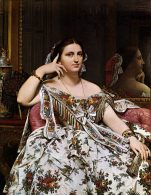
Madame Firmiani
THE HUMAN COMEDY – Honoré de Balzac First volume of works of Honoré de Balzac edited by widow André Houssiaux, publisher, Hebert and Co, successors, 7 rue Perronet – Paris (1877)
Scenes from private life 
MADAME FIRMIANI – “Woman study
Short story written in 1831 and published in the Revue de Paris in February 1832.
Analysis of the work Madame Firmiani, written in 1832, departs just as much as La paix du ménage from the usual methods and characters of Scènes de la vie privée , and shows the variety of tone and procedure that Balzac was already employing by this date. It’s a touching story of love, selflessness and delicacy between an elegant young woman approaching thirty and her very young lover, who leads the austere, hard-working life of a twenty-year-old Balzac. No study of a social milieu, no Paris neighborhood, no typical mores, just characters with little or no past and, above all, that pure, immaterial, interstellar atmosphere, so un-Balzacian, that suits the painting of noble sentiments. Why the change of scenery and tone? By 1832, Balzac, who had become a fashionable storyteller and contributor to elegant magazines, was no longer just a pitiless analyst to whom nothing of married life was foreign: he had become “the painter of women”. This enviable position was so well assured that Jules Janin, the wittiest critic of the time, mocked the specialty in which Balzac had become unbeatable, ranging from the most perceptive psychology to the most extensive knowledge of fashions, belts, stockings and boudoirs. During this period, Balzac multiplied the quick sketches and “profiles” of women, both in his short stories and in a few pages in magazines. In fact, he found this vocation so advantageous that he planned to assemble his sketches of young women in a set entitled Etudes de femmes, which was to provide three handsome in-8° volumes: they were offered in vain to the publisher Mame in 1832. Madame Firmiani is one of these “women’s studies”. The three short stories that accompany La paix du ménage, already mentioned, Etude de femme and Le message, which appeared in bookshops in the first and second series of Scènes de la vie privée, belong to this group. It was still private life, but on a different floor, more worldly, and with a different staff. And for Balzac, it was another way of drawing on his memories, not a storehouse of anecdotes, but memories of his own past. It’s not difficult to recognize in the young woman in her late thirties, so delicate, yet rich in experience, an initiator, and in the twenty-year-old man who is her lover, the couple formed in 1822 by Balzac, then twenty-three, and Mme de Berny, much older than him. Ten years later, this tribute was also a farewell. Madame Firmiani (was published in the February 1832 issue of the Revue de Paris. Six months later, Balzac was on his way to Aix-les-Bains to meet a new love, the Marquise de Castries. Mme de Berny was then fifty-five. The short story with the titleWomen’s studywhich Balzac would later use for his collection of short stories, had appeared in February 1830 in a luxury monthly, La ModeDevéria’s colorful “toilettes” were traditionally accompanied by spiritual “scenes” signed by well-known names. In these “pochades” written for women’s magazines, the authors generally confined themselves to delicately describing a few situations from worldly life. People’s names were often replaced by asterisks to give the impression of indiscreet anecdotes. This was the case for Etude de femme: the names of the characters in La Comédie humaine that we can read today were assigned later by Balzac to link this story to his body of work. So it’s only by chance that this tale is one of those “études de femmes” that Balzac conceived later, but which were never published and were appended to the Scènes de la vie privée collection. There’s just one noteworthy feature in this brief account: an ironic sketch of the pious young Parisian women from the parish of Saint-Thomas-d’Aquin, whom the Restoration’s “moral recovery” had made fashionable on the eve of the 1830 Revolution.
History It’s a touching story of love, selflessness and delicacy between an elegant young woman approaching her thirties and her very young lover, Octave de Camps, who leads the austere, hard-working life of a professor giving lessons. Madame Firmiani, the childless widow of Mr. Firmiani, a forty-something who could only offer her his name and immense fortune, is a fine, delicate person. His purity and probity earned him the respect of high society. Octave, who owns a fortune stolen by his father from the Bourgneuf family, Madame Firmiani, asks him to choose between this dishonest fortune and their love. She will be his judge of conscience. Octave gives math lessons to restore the stolen money, pay back the Bourgneuf family and win his sweetheart’s heart forever. Rich in experience, she initiated the Parisian education of her lover Octave, who later became her husband, and whom she loved sincerely. Paris, February 1831
Genealogy of characters Firmiani: Receiver General, disappeared around 1822. Married a Cadignan. Widowed, she married Octave de Camps. Octave de Camps: born around 1802, married a Cadignan, widow Firmiani, born before 1797.
Source analysis/history: Preface from Volume III, compiled from the complete works of the Comédie Humaine published by France Loisirs 1985 under the auspices of the Société des Amis d’Honoré de Balzac.
Character genealogy source: Félicien Marceau “Balzac and his world”.
No Comments